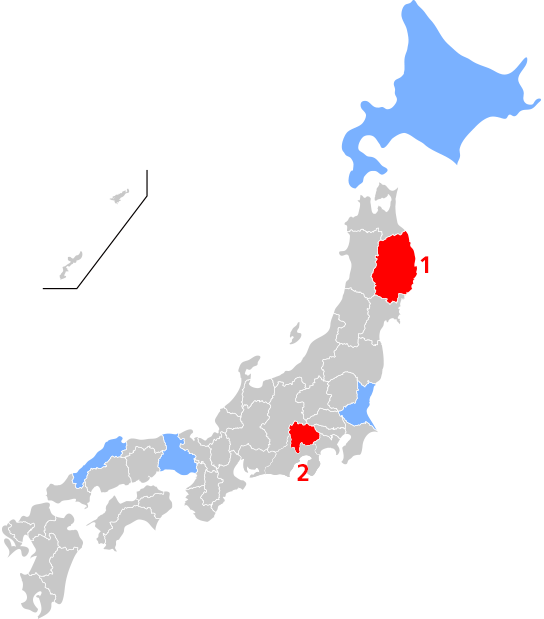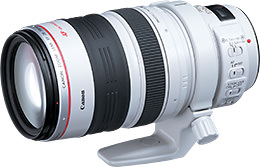Stunning Summer Landscapes: Scenic Spots in Japan & Pro Photography Tips (3)
Travelling to Japan? In this third article of the series, Japanese professional photographers share two more places that will make for stunning landscape photos in summer. Read on for photography tips such as the best times of the day to shoot, compositions that you can use, and so on. (Reported by: Hirokazu Nagane, Katsuhiro Yamanashi)

1. Kitakami Line (Iwate Prefecture)

EOS 5D Mark III/ EF24-70mm f/2.8L II USM/ FL: 24mm/ Manual exposure (f/8, 1/400 sec, EV±0)/ ISO 400/ WB: Daylight
Photo by Hirokazu Nagane
Location: Nishiwaga-machi, Waga-gun, Iwate Prefecture (Yuda Kinshuko - Hottoyuda)/ Best timing for shooting: Late August/ Time of shoot: 7am
Photographing the landscape and railroad reflected in the waters of Kinshuko
A famous photography spot on the Kitakami Line. This location is a highlight along the rail line, and is a highly popular spot for photographers. Try visiting in the early morning if you are going to take photos. The air then is often still, so you can see the landscape reflected in the mirror-like water. By shooting in portrait orientation, I was able to capture a wide view of the landscape reflected on the lake, deliberately placing the train in the centre of the bridge to evoke a sense of symmetry.
Because the inbound and outbound trains passed each other at almost the same time, I was able to take photos in both vertical and horizontal orientation. Vertical orientation seems to be the better choice when you consider how the reflection of the clouds on the water’s surface appear. Moreover, a single-car train seems to be a better match for this landscape than a two-car train.
Failed shot: In horizontal orientation, the frame was restrictive

EOS 5D Mark III/ EF24-70mm f/2.8L II USM/ FL: 33mm/ Manual exposure (f/8, 1/400 sec, EV±0)/ ISO 400/ WB: Daylight
Photo by Hirokazu Nagane
In terms of composition, the horizontal orientation works reasonably well. However, the depiction of the clouds reflected on the water’s surface is lacking.
Composition isn’t just about the rule-of-thirds. Here are some advanced composition techniques:
“Visual Guidance”, “Unexpectedness”, and “Subtraction”
“Pattern & Rhythm” & “S-Curve”
2. Amariyama (Yamanashi Prefecture)

EOS 5D Mark III/ EF24-105mm f/4L IS USM/ FL: 50mm/ Aperture-priority AE (f/8, 16 sec, EV±0)/ ISO 100/ WB: Auto
Photo by Katsuhiro Yamanashi
Location: Nirasaki-shi, Yamanashi Prefecture/ Best timing for shooting: Mid-August/ Time of shoot: 4:30am
Unique combination of the city lights of the Kofu Basin and Mt. Fuji
There was fair weather the night before so I decided to head to the photography spot with the help of a flashlight. Through a gap in the sea of clouds, I could see the lights twinkling in the Kofu basin. I then positioned the lights and Mt. Fuji between the larch trees. Both the city lights and the dawn sky were bright. Scenes like this do not require exposure compensation.
Tip: Aim to capture the form of the sea of clouds as it changes from blue to orange
The next shot was taken one hour after the main shot, immediately after sunrise. The sea of clouds becomes increasingly redder as it is warmed up by the sun, and starts to stir as if it has awakened, with its form changing from moment to moment. I wanted to capture the form of the sea of clouds in detail as it continued to change over time.

EOS 5D Mark III/ EF28-300mm f/3.5-5.6L IS USM/ FL: 80mm/ Aperture-priority AE (f/16, 1/8 sec, EV ±0)/ISO 100/WB: Auto
Photo by Katsuhiro Yamanashi
There is a momentary photo opportunity in the time when the blueish clouds seen before sunrise turn orange as they become soaked in sunlight, so prepare yourself before taking on this photo shoot.
Read these articles to for more tips on how to nail that early morning shot:
Early Morning Landscape Photography: To Shoot Before or After Sunrise?
Capturing Breathtaking Landscapes Under Ever-Changing Lighting Conditions
4 Keys to Shooting Pre-dawn Landscapes
Capture the Fiery, Vibrant Colours of Sunrise

1: Kitakami Line (Iwate Prefecture)
2: Amariyama (Yamanashi Prefecture)
Regions coloured in blue have been covered in the article below:
Stunning Summer Landscapes: Scenic Spots in Japan & Pro Photography Tips (1)
Stunning Summer Landscapes: Scenic Spots in Japan & Pro Photography Tips (2)
Receive the latest update on photography news, tips and tricks.
Be part of the SNAPSHOT Community.
Sign Up Now!
About the Author
A monthly magazine that believes that enjoyment of photography will increase the more one learns about camera functions. It delivers news on the latest cameras and features and regularly introduces various photography techniques.
Published by Impress Corporation
Born in Yokohama in 1974. After graduating from the Musashi Institute of Technology (Currently referred to as ‘Tokyo City University’), he studied under railway photographer Mitsuhide Mashima, who is the CEO of Mashima Railway Pictures. In recent years, he was involved in explaining railway photography techniques in photography magazines, and writing railway photography guides. He goes round Japan taking photos of trains while upholding the motto of “taking photos so true to life that you can hear the sound of the train just by looking at the photos”.
Born in Tokyo in 1945, Yamanashi worked at a publishing company after his graduation from the Tokyo College of Photography (now known as the Tokyo Polytechnic University), and for 4 years, journeyed around Japan visiting and photographing famous sightseeing spots. After he left the company, he became a freelance photographer, eventually establishing his own company, Yamanashi Photo, in 1989. Besides taking stock images, he also provides photographs for corporate calendars, camera and travel magazines, and posters for Japan Railways.



































